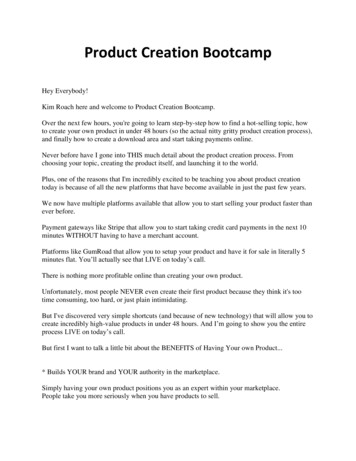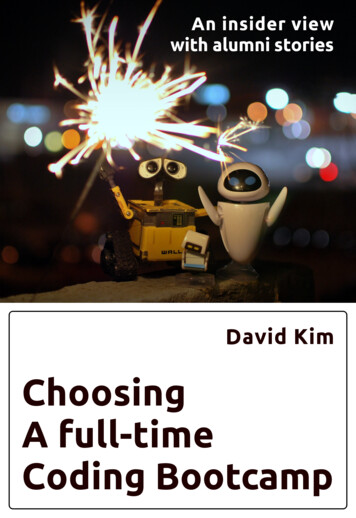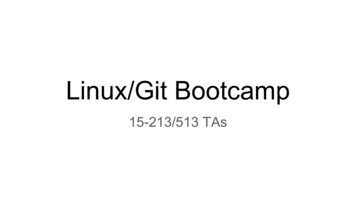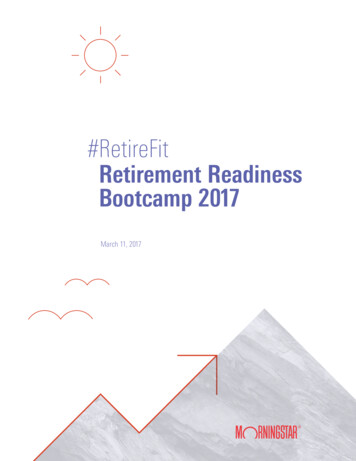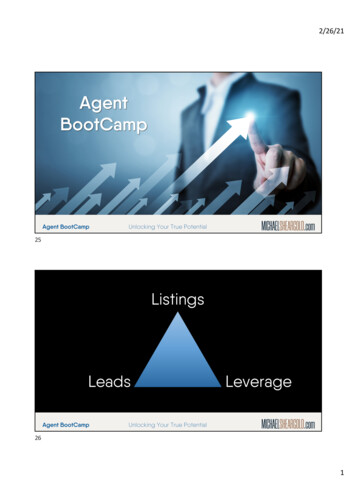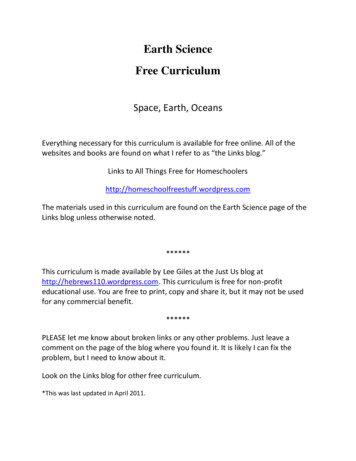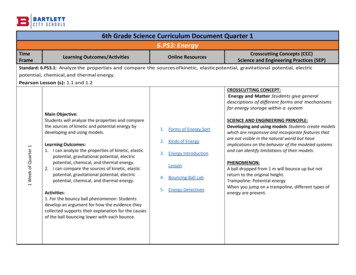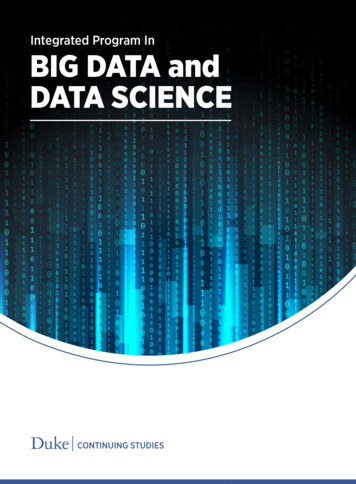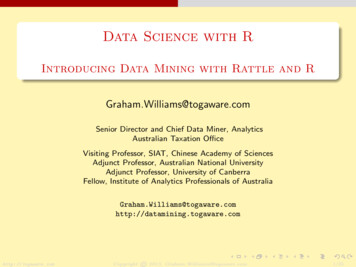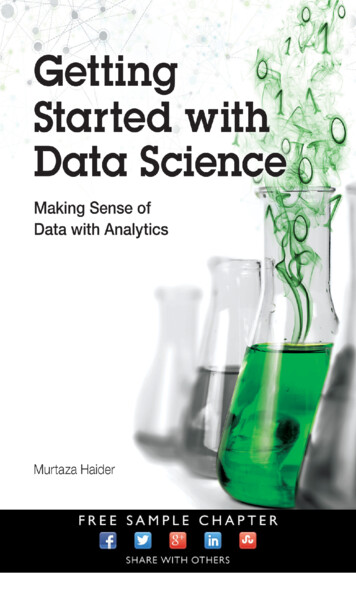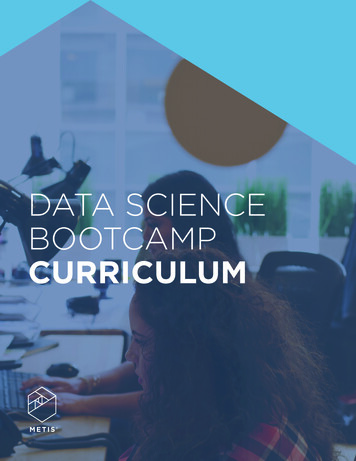
Transcription
DATA SCIENCEBOOTCAMPCURRICULUM
IntroductionThe Metis Data Science Bootcamp is a full-time, twelve-week intensive experience thathones, expands, and contextualizes the skills brought in by our competitive student cohorts,who come from varied backgrounds. Incorporating traditional in-class instruction in theoryand technique, students use real data to build a five-project portfolio to present to potentialemployers. Upon graduating, students have completed rigorous training in machinelearning, programming in multiple languages (Python, Unix, JavaScript), data wrangling,project design, and communication of results for integration in a business environment.Parallel to this core classroom work is a supporting careers curriculum created andimplemented by our Careers Team, which works with each student to secure employmentrapidly after graduation with a compatible employer.Each project is a start-to-finish application of the skills needed to be a well-rounded,competitive practitioner in the data science workforce. Each highlights the skills needed inevery “facet” of data science: project design, data acquisition and storage, tool selection,analysis, interpretation, and communication. In succession, the projects deepen in bothdifficulty and independence.
Online Pre-workOnce students are enrolled in the bootcamp, they are granted immediate access to our prework materials, a structured program of 25 hours of academic pre-work and up to 35 hoursof set-up is designed to get admitted students warmed up and ready to go. All exercisesmust be completed before the first day of class.Students are also invited to join their cohort’s Slack communication channel, where theymeet their TA, get support on pre-work assignments, and will be held accountable to thepre-work schedule of deadlines.PRE-WORK TOPICSGitHubSoftware & package installationCode editor selection & familiarityCommand line (OS X/bash)Python (intermediate & advanced)Linear AlgebraStatisticsOptional resources for review:Pandas, SQL, HTML/CSS/JavaScript
Twelve-WeekOnsite BootcampAfter completing pre-work, the cohort convenes on-site for the full bootcamp experience.The first eight weeks are spent learning the theory, skills, and tools of modern data sciencethrough iterative, project-centered skill acquisition. Over the course of four data scienceprojects, we “train up” different key aspects of data science, and results from each projectare added to the students’ portfolios. In the final four weeks, students build out andcomplete individual Passion Projects, culminating in a Career Day reveal of their work torepresentatives from our Metis Hiring Network.FLOW OF THE DAYMornings in the classroom // 9:30am – 12:00pm Pair programming exercises Interactive lectures90-minute lunch // 12:00pm – 1:30pm Long enough to take a coffee meeting, eat a great lunch, and/or just rest your brainWorking afternoons // 1:30pm – 6:00pm Investigation presentations Challenges and project work Senior Data Scientist instructors and Data Scientist TAs onsite for helpMore Careers curriculum Guest speakers Hosted Meetup events Site visits to select hiring partners
CURRICULUMDETAIL
WEEK 1UNIT ONEIntroduction to the Data Science ToolkitStudents jump right in, working with real data as they become acclimated with the core toolset that isused for the remainder of the bootcamp. Starting with a dirty dataset of turnstile entrances and exits fromthe New York MTA, students use Python, pandas, and matplotlib to find and present patterns in the data.Students create a blog using Jekyll and GitHub Pages to present findings from this and future projects.TOPICSPythonData wrangling and EDA (Exploratory Data Analysis) with Python, pandas, and matplotlibGit and GitHub workflow: branching and pull requestsBash shellGitHub Pages & JekyllPROJECT #1:CODENAMEBENSONStudents work in small groups using MTA turnstile data,which they clean themselves, to find patterns in thevolume of street traffic. Since no data project exists in avacuum, each group creates a theoretical client and usecase for its findings, brainstorming as a unit and usingdesign thinking principles. Projects are presented tothe class and published as posts on each student’s newGitHub Pages blog.
WEEK 2UNIT TWO: PART 1Fundamentals, Regression, and Web ScrapingThe basic workflow is now in place, and we dive into some deeper content. The second project focuses onregression and also touches on fundamental concepts for statistics and probability. For data acquisition,we tackle web scraping (used to gather data for the second project), stored in flat files using fundamentalPython input/output. With an eye on our goal to develop well-rounded data scientists, we go over designthinking and the iterative design process, so all efforts have the maximum impact on the intended audience.TOPICSProbability theory (discrete, continuous)Hypothesis testingRegression & model evaluation in statsmodels and scikit-learnWeb scraping with BeautifulSoup and SeleniumIterative design and design thinkingCAREER SERVICESFirst One-on-One Meeting with Career AdvisorStudents have their first of three officially-scheduled meetings with their Career Advisor, all of whichtake place during and after the bootcamp. Students can discuss topics like resumes, salary negotiation,mock interviews, company introductions, how to craft messages to hiring managers and recruiters, softskill interviewing, and more.Speaker Series begins (Weeks 2-9)During the bootcamp, students are exposed to a number of speakers, including ones from our HiringNetwork. These speakers provide deep-dives into specific skills and/or career coaching advice andrepresent excellent opportunities to expand your data science knowledge and network.
WEEK 3UNIT TWO: PART 2Advanced Regression and Communicating ResultsContinuing with the topics from Week 2, we introduce Bayes Theorem, another fundamental skillin statistical reasoning. Our regression models are refined as we learn about regression modelassumptions, transformations, and overfitting. Cross validation and regularization methods help torefine models further, and in preparing for the upcoming Project Luther, we deepen our plotting skills inmatplotlib and seaborn.TOPICSMachine learning concepts: overfitting and train/test splitsIntroduction to Bayes TheoremLinear Regression: model assumptions, regularization (lasso, ridge, elastic net)Advanced plotting with matplotlib and seabornPROJECT #2:CODENAMELUTHERIn the second project, we introduce every singlefacet of data science that will come into play for allfuture projects, including design, data acquisition,algorithms & analysis, tool selection, and interpretation/communication. Students use regression to predict boxoffice gross, using data they scrape themselves (fromweb sources of their choice), which they then store in flatfiles. Students make decisions about regularization andevaluate models using statsmodels or scikit-learn. Eachstudent interprets and presents their individual work to a“client” who would be interested in the findings.
WEEK 4UNIT THREE: PART 1Machine Learning Concepts, Classification, DatabasesThe third unit broadens concepts learned in regression by extending to the parent family of supervisedlearning. Students learn a suite of classification algorithms and concepts of bias-variance tradeoff. Sincethey work in groups for the upcoming Project McNulty, we create cloud servers to store project data, thistime in SQL databases.TOPICSClassification and regression algorithms: K-nearest neighbors, logistic regression,support vector machines (SVM), decision trees, and random forestDatabases: SQLMachine learning concepts: bias-variance tradeoff, classification errorsOther tools: creating and provisioning cloud serversCAREER SERVICESLinkedIn WorkshopLearn to build a LinkedIn profile that is specifically suited for data science jobs. Students incorporatetheir previous work experience and learn how to best position themselves for competitive opportunities.
WEEK 5UNIT THREE: PART 2Supervised Learning, More Topics in Machine LearningContinuing from Week 4, students add several more supervised learning algorithms to their arsenals,which they apply to their project data in the afternoons. Machine learning topics taught this week involvedeeper use of scikit-learn functionality, introducing automated methods of feature selection, options forestimation including stochastic gradient descent, and advanced metrics for model evaluation. Finally, newprobability distributions are added to our growing toolbox of fundamental statistical concepts.TOPICSMore supervised learning algorithms: Naive Bayes, Categorical MLE, PoissonRegression, Neural networks, and Deep learningMachine learning: automated feature selection, stochastic gradient descent,advanced model evaluationFundamentals: binomial, bernoulli, and poisson distributionsCAREER SERVICESNetworking WorkshopWe throw a mock networking event (attended only by members of the cohort) to help students learnhow to navigate – and build confidence to attend – industry events and Meetups.Resume WorkshopLearn how to craft a professional resume that is ready to present to employers by Career Day.
WEEK 6UNIT THREE: PART 3JavaScript and D3.jsThis week provides the final component for the upcoming Project McNulty, in which students finalizetheir analyses and create interactive dashboards to display results. We diverge from our all-Python dietto take on JavaScript and the data visualization toolkit, D3.js. The end product is an interactive andprofessional custom dashboard. Creating it presents meaningful exposure to the soup-to-nuts basics ofweb-based data presentation.TOPICSJavaScript and D3.jsFull stack in a nutshell: connecting a front end and a back end with Python FlaskDashboard designPROJECT #3:CODENAMEMCNULTYThis time, students get a break from data acquisition,and store data from one of the UCI repository datasetsin an SQL database. Using supervised learning, theycreate a dashboard for a company or data product usingD3.js, presenting predictions made on their data. Thesedashboards pull from a database API they create in Flaskto serve data into their interactive visualizations.
WEEK 7UNIT FOUR: PART 1Unsupervised Learning, NLP, Dimension Reduction,NoSQLWe dive into unsupervised learning and natural language processing (NLP), and go deep into coremachine learning concepts like the curse of dimensionality, dimension reduction, vector spaces, anddistance metrics. Finally, to support the upcoming Project Fletcher, we introduce NoSQL databases andRESTful APIs, as well as begin culling project data from web APIs to be stored in MongoDB.TOPICSData & databases: RESTful APIs, NoSQL databases, MongoDB, pymongoNatural language processing: textblob, NLTK, chunking, stemming, POS tagging, tf-idfUnsupervised learning: overview & introduction, K-meansMachine learning topics: curse of dimensionality, dimension reduction, PCA, SVD, LSICAREER SERVICESInterview Preparation WorkshopStudents learn the dos & don’ts of the interview process, including important tips to help achievesuccessful interviews.
WEEK 8UNIT FOUR: PART 2Natural Language Processing (NLP)Finishing up the main 8-week content component of the bootcamp, the final week of Project Fletchercontinues with Natural Language Processing (NLP) tools including topic modeling, latent dirichletallocation, and word2vec. We add several more unsupervised learning algorithms to our arsenal, andlearn formally about varieties of, and considerations in, choosing distance metrics.TOPICSNLP: Topic modeling, LDA, word2vecUnsupervised learning: hierarchical clustering, DBSCAN, Mean Shift, SpectralMachine learning topics: distance metricsPROJECT #4:CODENAMEFLETCHERFor the last (and most lightly) guided project, studentswork individually and have very few constraints forthe design. They must keep all facets of a data scienceproject in mind, however, including designing theiranalysis thinking of a specific audience and use case,choosing and collecting their data (which must includetext data and data sourced from an API), storing (atleast some of) it in a NoSQL database, using NLP andunsupervised learning techniques in their analysis, andinterpreting and presenting their findings in a way thatmakes sense for their use case.
WEEK 9-12UNIT FIVEBig Data Tools and Passion ProjectDuring the final four weeks, students transition into full-time focus on their final, passion projects. Week9 includes final lectures and challenges for big data tools and techniques, but for the rest of Unit 5, theywork with instructors to build out their passion project for Career Day. Each hones their presentation overmany iterations to showcase the work in its best light when it counts the most!TOPICSBig data tools: Hadoop, Hive, Pig, Spark, Cloud servers 2Algorithms: MapReduceProject and time management: iterative design, minimum viable productsCAREER SERVICESWEEK 9: Data Science Career PathsWorkshopStudents get their burning questions answeredaround differences in job titles, how skills vary byindustry, the impact of an advance degree, and more.Salary Negotiations WorkshopLearn the latest data scientist salary information andwalk through salary negotiation best practices.WEEK 10: Second One-on-One Meetingwith Career AdvisorMock InterviewsToward the end of the bootcamp, studentsparticipate in a mock technical interview conductedby data scientists from the Metis Hiring Network.They have the opportunity to “whiteboard” andrespond to typically asked data science questions.Afterward, they get feedback on their performance.WEEK 11: Career Day PreparationLeading up to Career Day, students have multipleopportunities to demo their final project in front ofMetis staff, students, and instructors – and all receivepersonalized feedback to help them better preparefor Career Day.WEEK 12: Career DayDuring the final week of the bootcamp, we hostCareer Day, at which students are introduced tocompanies actively hiring for data scientists. Eachpresents their final project and networks withattendees throughout the event. Participatingcompanies have included Capital One Labs, BoozAllen Hamilton, Spotify, Zynga, and HBO.
PROJECT #5:CODENAME KOJAK(AKA, PASSION PROJECT)For the last (and most lightly) guided project, students work individuallyand have very few constraints for the design. They must keep all facets ofa data science project in mind, however, including designing their analysisthinking of a specific audience and use case, choosing and collectingtheir data (which must include text data and data sourced from anAPI), storing (at least some of) it in a NoSQL database, using NLP andunsupervised learning techniques in their analysis, and interpreting andpresenting their findings in a way that makes sense for their use case.CAREER SERVICESPost-Graduation SupportUpon graduating, students get access to the Metis Alumni Network on Slack(including our exclusive Job Postings Channel), the Employ hiring app, and ourAlumni Resources folder. Until employed, you also receive tailored informationregarding open job opportunities that fit your interests and skills. Additionally,within four weeks of graduation, you can schedule another meeting with yourCareer Advisor.
More About ProjectsData science projects can be divided into the useful dimensions of domain, design, data,algorithms, tools, and communication. Each unit covers certain content from severaldomains, which are reinforced in that unit’s project.The rigor with which we attack the topics covered in the bootcamp allows us to sleepsoundly at night. We feel confident in saying that our graduates haven’t simply learned aboutthe tools data scientists use, but rather, by the time they leave our classroom, they are datascientists. They are ready to approach the problem space in their new careers, assemble thesuite of tools and methods to answer insightful questions, and communicate comprehensibleresults. They are competent, capable, and confident – and they are ready to work.
ObjectivesUpon graduating from the Metis Data Science Bootcamp, students are prepared forpositions on teams hiring for data scientists or data analysts. This means a student will:Have a fluid understanding of, and practical experience with, theprocess of designing, implementing, and communicating the results ofa data science project.Be a capable coder in Python and at the command line, including therelated packages and toolsets most commonly used in data science.Understand the landscape of data science tools and their applications,and will be prepared to identify and dig into new technologies andalgorithms needed for the job at hand.Know the fundamentals of data visualization and will have experiencecreating static and dynamic data visuals using JavaScript and D3.js.Have introductory exposure to modern big data tools and architecture,such as Hadoop and Spark – and they will know when these tools arenecessary and will be poised to quickly train up and utilize them in abig data project.
Kaplan, Inc. D/B/A Metis is accredited by the accrediting council for Continuing Education (ACCET), A U.S. Department of Education Nationally Recognized Agency
JavaScript and D3.js JavaScript and D3.js Full stack in a nutshell: connecting a front end and a back end with Python Flask Dashboard design WEEK 6 PROJECT #3: CODENAME MCNULTY This time, students get a break from data acquisition, and store data from one of the UCI repository dat

